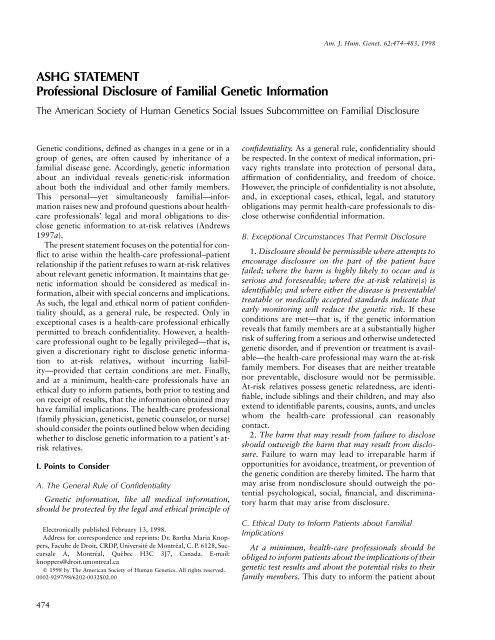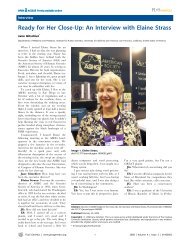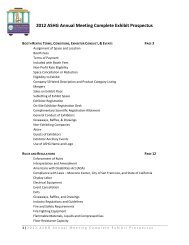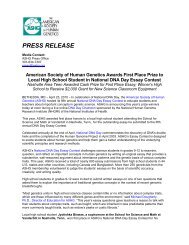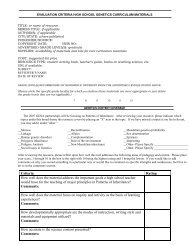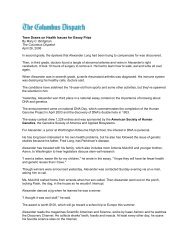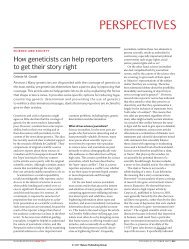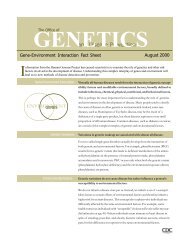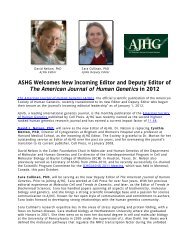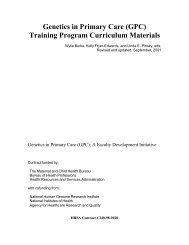ASHG Statement on Professional Disclosure of Familial Genetic ...
ASHG Statement on Professional Disclosure of Familial Genetic ...
ASHG Statement on Professional Disclosure of Familial Genetic ...
Create successful ePaper yourself
Turn your PDF publications into a flip-book with our unique Google optimized e-Paper software.
Am. J. Hum. Genet. 62:474–483, 1998<br />
<str<strong>on</strong>g>ASHG</str<strong>on</strong>g> STATEMENT<br />
Pr<strong>of</strong>essi<strong>on</strong>al <strong>Disclosure</strong> <strong>of</strong> <strong>Familial</strong> <strong>Genetic</strong> Informati<strong>on</strong><br />
The American Society <strong>of</strong> Human <strong>Genetic</strong>s Social Issues Subcommittee <strong>on</strong> <strong>Familial</strong> <strong>Disclosure</strong><br />
<strong>Genetic</strong> c<strong>on</strong>diti<strong>on</strong>s, defined as changes in a gene or in a<br />
group <strong>of</strong> genes, are <strong>of</strong>ten caused by inheritance <strong>of</strong> a<br />
familial disease gene. Accordingly, genetic informati<strong>on</strong><br />
about an individual reveals genetic-risk informati<strong>on</strong><br />
about both the individual and other family members.<br />
This pers<strong>on</strong>al—yet simultaneously familial—informati<strong>on</strong><br />
raises new and pr<strong>of</strong>ound questi<strong>on</strong>s about healthcare<br />
pr<strong>of</strong>essi<strong>on</strong>als’ legal and moral obligati<strong>on</strong>s to disclose<br />
genetic informati<strong>on</strong> to at-risk relatives (Andrews<br />
1997a).<br />
The present statement focuses <strong>on</strong> the potential for c<strong>on</strong>flict<br />
to arise within the health-care pr<strong>of</strong>essi<strong>on</strong>al–patient<br />
relati<strong>on</strong>ship if the patient refuses to warn at-risk relatives<br />
about relevant genetic informati<strong>on</strong>. It maintains that genetic<br />
informati<strong>on</strong> should be c<strong>on</strong>sidered as medical informati<strong>on</strong>,<br />
albeit with special c<strong>on</strong>cerns and implicati<strong>on</strong>s.<br />
As such, the legal and ethical norm <strong>of</strong> patient c<strong>on</strong>fidentiality<br />
should, as a general rule, be respected. Only in<br />
excepti<strong>on</strong>al cases is a health-care pr<strong>of</strong>essi<strong>on</strong>al ethically<br />
permitted to breach c<strong>on</strong>fidentiality. However, a healthcare<br />
pr<strong>of</strong>essi<strong>on</strong>al ought to be legally privileged—that is,<br />
given a discreti<strong>on</strong>ary right to disclose genetic informati<strong>on</strong><br />
to at-risk relatives, without incurring liability—provided<br />
that certain c<strong>on</strong>diti<strong>on</strong>s are met. Finally,<br />
and at a minimum, health-care pr<strong>of</strong>essi<strong>on</strong>als have an<br />
ethical duty to inform patients, both prior to testing and<br />
<strong>on</strong> receipt <strong>of</strong> results, that the informati<strong>on</strong> obtained may<br />
have familial implicati<strong>on</strong>s. The health-care pr<strong>of</strong>essi<strong>on</strong>al<br />
(family physician, geneticist, genetic counselor, or nurse)<br />
should c<strong>on</strong>sider the points outlined below when deciding<br />
whether to disclose genetic informati<strong>on</strong> to a patient’s atrisk<br />
relatives.<br />
I. Points to C<strong>on</strong>sider<br />
A. The General Rule <strong>of</strong> C<strong>on</strong>fidentiality<br />
<strong>Genetic</strong> informati<strong>on</strong>, like all medical informati<strong>on</strong>,<br />
should be protected by the legal and ethical principle <strong>of</strong><br />
Electr<strong>on</strong>ically published February 13, 1998.<br />
Address for corresp<strong>on</strong>dence and reprints: Dr. Bartha Maria Knoppers,<br />
Faculte de Droit, CRDP, Université de M<strong>on</strong>tréal, C. P. 6128, Succursale<br />
A, M<strong>on</strong>tréal, Québec H3C 3J7, Canada. E-mail:<br />
knoppers@droit.um<strong>on</strong>treal.ca<br />
1998 by The American Society <strong>of</strong> Human <strong>Genetic</strong>s. All rights reserved.<br />
0002-9297/98/6202-0032$02.00<br />
c<strong>on</strong>fidentiality. As a general rule, c<strong>on</strong>fidentiality should<br />
be respected. In the c<strong>on</strong>text <strong>of</strong> medical informati<strong>on</strong>, privacy<br />
rights translate into protecti<strong>on</strong> <strong>of</strong> pers<strong>on</strong>al data,<br />
affirmati<strong>on</strong> <strong>of</strong> c<strong>on</strong>fidentiality, and freedom <strong>of</strong> choice.<br />
However, the principle <strong>of</strong> c<strong>on</strong>fidentiality is not absolute,<br />
and, in excepti<strong>on</strong>al cases, ethical, legal, and statutory<br />
obligati<strong>on</strong>s may permit health-care pr<strong>of</strong>essi<strong>on</strong>als to disclose<br />
otherwise c<strong>on</strong>fidential informati<strong>on</strong>.<br />
B. Excepti<strong>on</strong>al Circumstances That Permit <strong>Disclosure</strong><br />
1. <strong>Disclosure</strong> should be permissible where attempts to<br />
encourage disclosure <strong>on</strong> the part <strong>of</strong> the patient have<br />
failed; where the harm is highly likely to occur and is<br />
serious and foreseeable; where the at-risk relative(s) is<br />
identifiable; and where either the disease is preventable/<br />
treatable or medically accepted standards indicate that<br />
early m<strong>on</strong>itoring will reduce the genetic risk. If these<br />
c<strong>on</strong>diti<strong>on</strong>s are met—that is, if the genetic informati<strong>on</strong><br />
reveals that family members are at a substantially higher<br />
risk <strong>of</strong> suffering from a serious and otherwise undetected<br />
genetic disorder, and if preventi<strong>on</strong> or treatment is available—the<br />
health-care pr<strong>of</strong>essi<strong>on</strong>al may warn the at-risk<br />
family members. For diseases that are neither treatable<br />
nor preventable, disclosure would not be permissible.<br />
At-risk relatives possess genetic relatedness, are identifiable,<br />
include siblings and their children, and may also<br />
extend to identifiable parents, cousins, aunts, and uncles<br />
whom the health-care pr<strong>of</strong>essi<strong>on</strong>al can reas<strong>on</strong>ably<br />
c<strong>on</strong>tact.<br />
2. The harm that may result from failure to disclose<br />
should outweigh the harm that may result from disclosure.<br />
Failure to warn may lead to irreparable harm if<br />
opportunities for avoidance, treatment, or preventi<strong>on</strong> <strong>of</strong><br />
the genetic c<strong>on</strong>diti<strong>on</strong> are thereby limited. The harm that<br />
may arise from n<strong>on</strong>disclosure should outweigh the potential<br />
psychological, social, financial, and discriminatory<br />
harm that may arise from disclosure.<br />
C. Ethical Duty to Inform Patients about <strong>Familial</strong><br />
Implicati<strong>on</strong>s<br />
At a minimum, health-care pr<strong>of</strong>essi<strong>on</strong>als should be<br />
obliged to inform patients about the implicati<strong>on</strong>s <strong>of</strong> their<br />
genetic test results and about the potential risks to their<br />
family members. This duty to inform the patient about<br />
474
<str<strong>on</strong>g>ASHG</str<strong>on</strong>g> Subcommittee <strong>on</strong> <strong>Familial</strong> <strong>Disclosure</strong>: <str<strong>on</strong>g>ASHG</str<strong>on</strong>g> <str<strong>on</strong>g>Statement</str<strong>on</strong>g> 475<br />
familial implicati<strong>on</strong>s, both prior to genetic testing and<br />
again if the patient refuses to communicate results, is<br />
paramount. It is presumed that most patients, provided<br />
with the proper informati<strong>on</strong>, will inform their relatives<br />
<strong>of</strong> potential risks so that early m<strong>on</strong>itoring, detecti<strong>on</strong>,<br />
and treatment are available to them.<br />
II. Background<br />
A. Ethical Frameworks for <strong>Disclosure</strong> <strong>of</strong> Otherwise<br />
C<strong>on</strong>fidential Informati<strong>on</strong><br />
There are four ethical positi<strong>on</strong>s regarding a healthcare<br />
pr<strong>of</strong>essi<strong>on</strong>al’s duty or privilege to warn at-risk relatives<br />
about genetic informati<strong>on</strong>. In the first paradigm,<br />
c<strong>on</strong>fidentiality is absolute, and all medical informati<strong>on</strong><br />
is strictly private. Although the health-care pr<strong>of</strong>essi<strong>on</strong>al<br />
may inform the patient about implicati<strong>on</strong>s for at-risk<br />
relatives, c<strong>on</strong>fidentiality prevents the health-care pr<strong>of</strong>essi<strong>on</strong>al<br />
from disclosing any genetic informati<strong>on</strong> to relatives;<br />
the health-care pr<strong>of</strong>essi<strong>on</strong>al has a duty not to<br />
breach c<strong>on</strong>fidentiality. From this viewpoint, it would be<br />
unethical to do so.<br />
Alternatively, the President’s Commissi<strong>on</strong> for the<br />
Study <strong>of</strong> Ethical Problems in Medicine and Biomedical<br />
and Behavioral Research (1983) proposed that healthcare–pr<strong>of</strong>essi<strong>on</strong>al<br />
disclosure to at-risk family members<br />
should take place <strong>on</strong>ly when (1) reas<strong>on</strong>able efforts to<br />
elicit voluntary c<strong>on</strong>sent to disclosure have failed; (2)<br />
there is a high probability that harm will occur if the<br />
informati<strong>on</strong> is withheld, and the disclosed informati<strong>on</strong><br />
will actually be used to avert harm; (3) the harm that<br />
would result to identifiable individuals would be serious;<br />
and (4) appropriate precauti<strong>on</strong>s are taken to ensure that<br />
<strong>on</strong>ly the genetic informati<strong>on</strong> needed for diagnosis and/<br />
or treatment <strong>of</strong> the disease in questi<strong>on</strong> is disclosed. These<br />
ethical guidelines do not imply a legal duty to warn; they<br />
simply set out circumstances in which the commissi<strong>on</strong><br />
believes it would be permissible to do so. The Institute<br />
<strong>of</strong> Medicine Committee (1994), in its report <strong>on</strong> the assessment<br />
<strong>of</strong> genetic risks, adopted similar language.<br />
A third possible approach involves warning the patient,<br />
before genetic testing, about the circumstances that<br />
would result in disclosure <strong>of</strong> genetic informati<strong>on</strong> to other<br />
family members, regardless <strong>of</strong> the patient’s intenti<strong>on</strong>s to<br />
disclose (Macklin 1992). In this way, arguably, the<br />
health-care pr<strong>of</strong>essi<strong>on</strong>al–patient relati<strong>on</strong>ship would not<br />
be jeopardized, as l<strong>on</strong>g as the health-care pr<strong>of</strong>essi<strong>on</strong>al<br />
assures the patient <strong>of</strong> the presumpti<strong>on</strong> <strong>of</strong> c<strong>on</strong>fidentiality<br />
and outlines the excepti<strong>on</strong>s to that presumpti<strong>on</strong>, prior<br />
to testing.<br />
Finally, the duty to warn could be c<strong>on</strong>sidered an ethical<br />
duty that might eventually become obligatory rather<br />
than permissive. Indeed, absence <strong>of</strong> explicit legal regulati<strong>on</strong>s<br />
does not translate into an absence <strong>of</strong> duty. An<br />
ethical duty can become a pr<strong>of</strong>essi<strong>on</strong>al norm <strong>of</strong> practice,<br />
and it may become the legal standard, as l<strong>on</strong>g as there<br />
are no important countervailing policy issues.<br />
B. The Duty to Warn under Law<br />
Statutes and legislati<strong>on</strong>, which protect the c<strong>on</strong>fidentiality<br />
<strong>of</strong> medical/genetic informati<strong>on</strong> in general, permit<br />
health-care pr<strong>of</strong>essi<strong>on</strong>als to disclose, in excepti<strong>on</strong>al<br />
cases, otherwise c<strong>on</strong>fidential informati<strong>on</strong>, without incurring<br />
liability. Physicians are required, <strong>on</strong> the basis <strong>of</strong><br />
public-policy interests, to report, to the appropriate authorities,<br />
communicable diseases, gunshot and other<br />
wounds, and evidence <strong>of</strong> child abuse and neglect.<br />
U.S. case law dealing with the general duty to warn<br />
identifiable third parties <strong>of</strong> a threat <strong>of</strong> violence (Taras<strong>of</strong>f<br />
v. Regents <strong>of</strong> the University <strong>of</strong> California, 551 P. 2d 334<br />
[CA 1976] [en banc]) found that a duty to warn is likely<br />
to exist if (1) the physician has a special relati<strong>on</strong>ship<br />
with either the pers<strong>on</strong> who may cause the harm or the<br />
potential victim, (2) the potential victim or pers<strong>on</strong> at<br />
risk is identifiable, and (3) the harm to the victim is<br />
foreseeable and serious. Such a duty has been distinguished<br />
from a possible duty to warn at-risk relatives<br />
about potential genetic risk, ins<strong>of</strong>ar as it is the patient’s<br />
acti<strong>on</strong>s that are likely to harm others in the former case,<br />
whereas in the latter case the patient is not putting relatives<br />
at risk by simply carrying the gene mutati<strong>on</strong>—the<br />
relatives already either have or do not have the mutati<strong>on</strong><br />
(Suter 1993; Park and Dickens 1995)).<br />
More specifically, a health-care pr<strong>of</strong>essi<strong>on</strong>al’s duty to<br />
warn in the c<strong>on</strong>text <strong>of</strong> genetic informati<strong>on</strong> was recently<br />
c<strong>on</strong>sidered by two U.S. courts. These cases may indicate<br />
an increasing trend toward disclosure: physicians were<br />
held to a duty to warn patients about familial implicati<strong>on</strong>s<br />
(Pate v. Threkel, 661 So. 2d 278 [FL 1995]),<br />
and, further, they were held to a duty to warn relatives<br />
known to be at risk (Safer v. Estate <strong>of</strong> Pack, 677 A 2d<br />
1188 [NJ Super A.D. 1996]), irrespective <strong>of</strong> potential<br />
c<strong>on</strong>flicts between the duty to warn and the obligati<strong>on</strong><br />
to protect c<strong>on</strong>fidentiality.<br />
C. Internati<strong>on</strong>al Trends and Positi<strong>on</strong>s<br />
Although the majority <strong>of</strong> foreign jurisdicti<strong>on</strong>s (e.g.,<br />
World Medical Associati<strong>on</strong>, World Health Organizati<strong>on</strong>,<br />
Council <strong>of</strong> Europe, Nuffield Council <strong>on</strong> Bioethics,<br />
Health Council <strong>of</strong> the Netherlands, and Privacy Commissi<strong>on</strong>er<br />
<strong>of</strong> Australia) maintain that c<strong>on</strong>fidentiality<br />
must be ensured and protected, the majority are also in<br />
favor <strong>of</strong> limited disclosure <strong>of</strong> genetic test results (without<br />
the c<strong>on</strong>sent <strong>of</strong> the patient) in cases where the harm to<br />
at-risk relatives is grave and imminent and where the<br />
disclosure <strong>of</strong> informati<strong>on</strong> could result in effective inter-
476 Am. J. Hum. Genet. 62:474–483, 1998<br />
venti<strong>on</strong>. Only a few jurisdicti<strong>on</strong>s (Norway, Swiss Academy<br />
<strong>of</strong> Medical Sciences, and possibly France’s Nati<strong>on</strong>al<br />
Ethics Committee) maintain that c<strong>on</strong>fidentiality is absolute<br />
and that the patient’s wishes with regard to n<strong>on</strong>disclosure<br />
must be respected at all times.<br />
III. Summary<br />
<strong>Genetic</strong> informati<strong>on</strong> should be c<strong>on</strong>sidered as medical<br />
informati<strong>on</strong>. However, genetic informati<strong>on</strong> is both individual<br />
and familial in nature. This raises c<strong>on</strong>flicts between<br />
the duty to protect c<strong>on</strong>fidentiality and the duty<br />
to warn. Yet ethical, legal, and statutory excepti<strong>on</strong>s limit<br />
the principle <strong>of</strong> c<strong>on</strong>fidentiality and, in specific and very<br />
limited circumstances, permit disclosure. It is clear that<br />
a health-care pr<strong>of</strong>essi<strong>on</strong>al has a positive duty to inform<br />
the patient about the potential genetic risks to the patient’s<br />
relatives. Moreover, where the harm is serious (a<br />
c<strong>on</strong>cept that defies exact definiti<strong>on</strong> and must be determined<br />
<strong>on</strong> an ad hoc basis [Knoppers et al. 1995]) and<br />
likely, and where preventi<strong>on</strong> or treatment is available,<br />
the health-care pr<strong>of</strong>essi<strong>on</strong>al may have a privilege to warn<br />
at-risk relatives, irrespective <strong>of</strong> the patient’s wishes. Although<br />
this positi<strong>on</strong> is in line with the emerging internati<strong>on</strong>al<br />
trend, the ethical duty <strong>of</strong> health-care pr<strong>of</strong>essi<strong>on</strong>als<br />
to warn patients’ at-risk relatives will<br />
undoubtedly be the topic <strong>of</strong> future debate.<br />
IV. Discussi<strong>on</strong><br />
<strong>Genetic</strong> c<strong>on</strong>diti<strong>on</strong>s are <strong>of</strong>ten caused by inheritance <strong>of</strong><br />
a familial disease gene. Accordingly, genetic informati<strong>on</strong><br />
about an individual reveals genetic-risk informati<strong>on</strong><br />
about both the individual and other family members.<br />
This pers<strong>on</strong>al—yet simultaneously familial—informati<strong>on</strong><br />
raises new and pr<strong>of</strong>ound questi<strong>on</strong>s about healthcare<br />
pr<strong>of</strong>essi<strong>on</strong>als’ legal and moral obligati<strong>on</strong>s to disclose<br />
genetic informati<strong>on</strong> to at-risk relatives (Andrews<br />
1997a, 1997b).<br />
Given the complex, n<strong>on</strong>individualistic nature <strong>of</strong> genetic<br />
informati<strong>on</strong>, some ethicists have maintained that<br />
it is “vital to recognize that hereditary informati<strong>on</strong> is a<br />
family possessi<strong>on</strong> rather than simply a pers<strong>on</strong>al <strong>on</strong>e.” 1<br />
Yet if genetic informati<strong>on</strong> is treated as “family property,”<br />
the traditi<strong>on</strong>al boundaries, definiti<strong>on</strong>s, and obligati<strong>on</strong>s<br />
<strong>of</strong> the health-care pr<strong>of</strong>essi<strong>on</strong>al–patient relati<strong>on</strong>ship<br />
would be extended to include family members, leaving<br />
the health-care pr<strong>of</strong>essi<strong>on</strong>al to deal with the potential<br />
c<strong>on</strong>flict between the best interests <strong>of</strong> the traditi<strong>on</strong>ally<br />
defined patient and the best interests <strong>of</strong> the newly defined<br />
1<br />
Wertz et al. (1995) suggest that, at the level <strong>of</strong> the pers<strong>on</strong>, genetic<br />
informati<strong>on</strong>, although individual, should “be shared am<strong>on</strong>g family<br />
members” as a form <strong>of</strong> shared familial property.<br />
“patients.” 2 The inherent limitati<strong>on</strong>s <strong>of</strong> test results to<br />
predict the <strong>on</strong>set, severity, or complexity <strong>of</strong> a disorder<br />
complicate even further the medical, legal, and ethical<br />
issues that surround disclosure <strong>of</strong> genetic informati<strong>on</strong> to<br />
at-risk relatives. Like all medical c<strong>on</strong>diti<strong>on</strong>s, genetic c<strong>on</strong>diti<strong>on</strong>s<br />
rarely exhibit homogeneity in terms <strong>of</strong> how the<br />
disease process manifests itself am<strong>on</strong>g affected individuals.<br />
Since some genetic c<strong>on</strong>diti<strong>on</strong>s are caused not by<br />
<strong>on</strong>e but by several genes, the combinati<strong>on</strong> <strong>of</strong> individual<br />
variati<strong>on</strong>s produces an even more complex set <strong>of</strong> potential<br />
clinical outcomes and <strong>of</strong>ten leads to more unknowns<br />
than definitive predicti<strong>on</strong>s (Abbott 1996;<br />
Beardsley 1996).<br />
Must the uniqueness <strong>of</strong> genetic informati<strong>on</strong> be established<br />
to justify a breach <strong>of</strong> c<strong>on</strong>fidentiality in the healthcare<br />
pr<strong>of</strong>essi<strong>on</strong>al–patient relati<strong>on</strong>ship and, thereby, to<br />
allow disclosure <strong>of</strong> genetic-risk informati<strong>on</strong> to relatives<br />
<strong>Genetic</strong> informati<strong>on</strong> has been described as unique not<br />
<strong>on</strong>ly because it is both individually identifying and transgenerati<strong>on</strong>ally<br />
familial, but also because it implies probabilistic<br />
risk informati<strong>on</strong>. Advocates <strong>of</strong> such genetic excepti<strong>on</strong>alism<br />
3 have urged that genetic testing warrants<br />
additi<strong>on</strong>al protecti<strong>on</strong>s because the informati<strong>on</strong> it yields<br />
can result in social discriminati<strong>on</strong> and stigmatizati<strong>on</strong><br />
(particularly in the areas <strong>of</strong> insurance and employment).<br />
While this genetic-excepti<strong>on</strong>alism argument maintains<br />
that genetic informati<strong>on</strong> is sufficiently distinct from<br />
other health-related informati<strong>on</strong> to warrant special privacy<br />
protecti<strong>on</strong>, the <str<strong>on</strong>g>ASHG</str<strong>on</strong>g> subcommittee maintains the<br />
more comm<strong>on</strong>ly held view that genetic informati<strong>on</strong><br />
should be c<strong>on</strong>sidered part <strong>of</strong> mainstream medical infor-<br />
2<br />
Gevers (1988) presents the noti<strong>on</strong> <strong>of</strong> genetic informati<strong>on</strong> as family<br />
property as a possible alternative to health-care pr<strong>of</strong>essi<strong>on</strong>al–patient<br />
c<strong>on</strong>fidentiality but ultimately rejects this approach, arguing that “[t]he<br />
infringements <strong>of</strong> the principle <strong>of</strong> c<strong>on</strong>fidentiality would be potentially<br />
unlimited, partly because it may be impossible to draw the line between<br />
medical informati<strong>on</strong> that is relevant to genetic counselling and informati<strong>on</strong><br />
that is not relevant, and partly because in the future ever more<br />
diseases will be found to c<strong>on</strong>tain hereditary comp<strong>on</strong>ents.” C<strong>on</strong>tra:<br />
Wertz et al. (1995), who adopt this family-property c<strong>on</strong>cept; see also<br />
Wachbroit (1989, 1993), who suggests a family-health model that<br />
c<strong>on</strong>templates the physician’s patient as the entire family; “family” is<br />
understood to refer to a genetic network rather than a social instituti<strong>on</strong>.<br />
Therefore, the physician’s duties pertain to the genetic family<br />
as a whole. de Wachter (1997) notes that “privacy seen as a family<br />
matter should be c<strong>on</strong>sidered.” He further notes the attenti<strong>on</strong> paid by<br />
the United Nati<strong>on</strong>s Educati<strong>on</strong>al, Scientific and Cultural Organizati<strong>on</strong><br />
(Unesco) to various c<strong>on</strong>cepts <strong>of</strong> privacy am<strong>on</strong>g societies, and he points<br />
out that “the duty <strong>of</strong> the health pr<strong>of</strong>essi<strong>on</strong>al is to secure the appropriate<br />
privacy for genetic informati<strong>on</strong> that is laid down by the norms <strong>of</strong> a<br />
particular society.”<br />
3<br />
See, for example, Annas et al. (1995), who believe that genetic<br />
informati<strong>on</strong> should be accorded special status and who note that “genetic<br />
informati<strong>on</strong> is uniquely powerful and uniquely pers<strong>on</strong>al, and thus<br />
merits unique privacy protecti<strong>on</strong>.”
<str<strong>on</strong>g>ASHG</str<strong>on</strong>g> Subcommittee <strong>on</strong> <strong>Familial</strong> <strong>Disclosure</strong>: <str<strong>on</strong>g>ASHG</str<strong>on</strong>g> <str<strong>on</strong>g>Statement</str<strong>on</strong>g> 477<br />
mati<strong>on</strong>, albeit with special c<strong>on</strong>cerns and implicati<strong>on</strong>s. 4<br />
Even those who believe that genetic informati<strong>on</strong> cannot<br />
be easily distinguished from other medical informati<strong>on</strong><br />
note that “genetic informati<strong>on</strong> does not have to be completely<br />
unique in order to warrant special protecti<strong>on</strong>”;<br />
it simply has to be treated as “distinctive and especially<br />
sensitive.” 5 Moreover, genetic excepti<strong>on</strong>alism <strong>on</strong>ly<br />
strengthens the noti<strong>on</strong>s <strong>of</strong> genetic determinism and genetic<br />
reducti<strong>on</strong>ism (Murray 1997).<br />
The c<strong>on</strong>tagious-disease model, <strong>of</strong>ten cited in discussi<strong>on</strong>s<br />
<strong>of</strong> potential duties to warn at-risk relatives, is not<br />
an ideal paradigm for the disclosure <strong>of</strong> genetic informati<strong>on</strong>.<br />
First, genetic c<strong>on</strong>diti<strong>on</strong>s are inherited—transmitted<br />
vertically through succeeding generati<strong>on</strong>s—and<br />
the c<strong>on</strong>necti<strong>on</strong>s are solely dependent <strong>on</strong><br />
biological relati<strong>on</strong>s. C<strong>on</strong>versely, c<strong>on</strong>tagious disease is<br />
generally transmitted horiz<strong>on</strong>tally (save for parent-<strong>of</strong>fspring<br />
transmissi<strong>on</strong>), and its impact <strong>on</strong> others occurs<br />
through some form <strong>of</strong> c<strong>on</strong>tact. Finally, c<strong>on</strong>tagious disease<br />
is c<strong>on</strong>trolled by isolati<strong>on</strong> <strong>of</strong> affected people, by<br />
avoidance <strong>of</strong> whatever c<strong>on</strong>tact causes infecti<strong>on</strong>, or by<br />
cure. <strong>Genetic</strong> c<strong>on</strong>diti<strong>on</strong>s, <strong>on</strong> the other hand, are c<strong>on</strong>trolled<br />
not <strong>on</strong>ly through preventi<strong>on</strong> or palliative treatment<br />
but also through reproductive decisi<strong>on</strong>s and<br />
choices (adopti<strong>on</strong>, reproductive technologies, etc.).<br />
We will now examine, in brief, the various ethical,<br />
legal, and internati<strong>on</strong>al c<strong>on</strong>texts with regard to the issue<br />
<strong>of</strong> disclosure <strong>of</strong> genetic informati<strong>on</strong> to at-risk family<br />
members. We will not, however, c<strong>on</strong>sider the particulars<br />
<strong>of</strong> disclosure to minors; to spouses, for the purposes <strong>of</strong><br />
4<br />
This issue has been addressed specifically in the literature, with<br />
regard to legislati<strong>on</strong> c<strong>on</strong>cerning genetic informati<strong>on</strong>. See Reilly (1997),<br />
who ultimately determines that, since genetic informati<strong>on</strong> will (in the<br />
not-too-distant future) become a standard part <strong>of</strong> the general medical<br />
record, laws that protect the privacy <strong>of</strong> all individual medical records,<br />
as opposed to laws that regulate genetic informati<strong>on</strong> specifically, are<br />
required. He notes that the Medical Records C<strong>on</strong>fidentiality Act <strong>of</strong><br />
1995 (s. 1360, 104th C<strong>on</strong>g., 1st sess., sec. 2[1]), for example, presents<br />
a reas<strong>on</strong>able general approach to medical informati<strong>on</strong> and that it<br />
would be comprehensive if “genetic informati<strong>on</strong>” were added to its<br />
list <strong>of</strong> protected entities. See also Gostin (1995), who notes that the<br />
enactment <strong>of</strong> genetic-specific privacy legislati<strong>on</strong> could create inc<strong>on</strong>sistencies<br />
in the rules that govern the disseminati<strong>on</strong> <strong>of</strong> health informati<strong>on</strong><br />
and that, since “the flow <strong>of</strong> medical informati<strong>on</strong> is rarely restricted to<br />
particular diseases or c<strong>on</strong>diti<strong>on</strong>s,” “comprehensive legislati<strong>on</strong> <strong>on</strong><br />
health informati<strong>on</strong> privacy, with explicit language applying privacy<br />
and security standards to genomic informati<strong>on</strong>” would be a better<br />
alternative. See also Knoppers (1997).<br />
5<br />
See Murray (1997, pp. 60–73). Murray rejects unique distincti<strong>on</strong>s<br />
between genetic informati<strong>on</strong> and other medical informati<strong>on</strong> and notes,<br />
inter alia, that cholesterol levels are probabilistic informati<strong>on</strong>, that<br />
other medical informati<strong>on</strong> affects the family (although sensitivity may<br />
be amplified with genetic informati<strong>on</strong>), and that discriminati<strong>on</strong> occurs<br />
with n<strong>on</strong>genetic informati<strong>on</strong>—as, for example, in the insurance<br />
industry.<br />
making informed reproductive choices 6 ; or to at-risk relatives<br />
who have the same family physician as the<br />
patient. 7<br />
V. C<strong>on</strong>texts<br />
A. Ethical C<strong>on</strong>siderati<strong>on</strong>s<br />
The c<strong>on</strong>cept <strong>of</strong> privacy has evolved, from a right <strong>of</strong><br />
privacy, to a pers<strong>on</strong>al right to be left al<strong>on</strong>e and, ultimately,<br />
to a fundamental right that is based <strong>on</strong> human<br />
dignity and respect for the individual—the latter noti<strong>on</strong><br />
being understood in terms <strong>of</strong> self-determinati<strong>on</strong> (Knoppers<br />
et al. 1995; LeBris and Knoppers 1997). Privacy<br />
rights, in the c<strong>on</strong>text <strong>of</strong> medical informati<strong>on</strong>, translate<br />
into protecti<strong>on</strong> <strong>of</strong> pers<strong>on</strong>al data and affirmati<strong>on</strong> <strong>of</strong> c<strong>on</strong>fidentiality.<br />
As such, genetic informati<strong>on</strong> is protected by<br />
the legal and ethical principle <strong>of</strong> c<strong>on</strong>fidentiality that exists<br />
within the health-care pr<strong>of</strong>essi<strong>on</strong>al–patient relati<strong>on</strong>ship.<br />
There is a comm<strong>on</strong>ly held view that, without an<br />
expectati<strong>on</strong> <strong>of</strong> c<strong>on</strong>fidentiality, patients will be less forthcoming<br />
in disclosing sensitive pers<strong>on</strong>al informati<strong>on</strong>.<br />
C<strong>on</strong>fidentiality, however, is not absolute. Codes <strong>of</strong><br />
medical ethics permit physicians, in excepti<strong>on</strong>al cases,<br />
to disclose otherwise c<strong>on</strong>fidential informati<strong>on</strong>. 8 Four<br />
ethical positi<strong>on</strong>s regarding a health-care pr<strong>of</strong>essi<strong>on</strong>al’s<br />
duty or privilege to warn at-risk relatives about genetic<br />
informati<strong>on</strong> are found in the literature.<br />
In the traditi<strong>on</strong>al health-care pr<strong>of</strong>essi<strong>on</strong>al–patient relati<strong>on</strong>ship,<br />
c<strong>on</strong>fidentiality is absolute. All medical informati<strong>on</strong><br />
is strictly private. Health-care pr<strong>of</strong>essi<strong>on</strong>als are<br />
obliged to inform patients about the implicati<strong>on</strong>s <strong>of</strong> their<br />
genetic test results and about the potential risks to family<br />
members. However, c<strong>on</strong>fidentiality prevents the healthcare<br />
pr<strong>of</strong>essi<strong>on</strong>al from disclosing any genetic informati<strong>on</strong><br />
to relatives; the health-care pr<strong>of</strong>essi<strong>on</strong>al has a duty<br />
not to breach c<strong>on</strong>fidentiality. From this viewpoint, it<br />
would be unethical to do so.<br />
Alternatives to this strict view <strong>of</strong> health-care pr<strong>of</strong>es-<br />
6<br />
The issue <strong>of</strong> disclosure to spouses is c<strong>on</strong>troversial; although there<br />
may be no pers<strong>on</strong>al risk to the spouse, genetic test results are pertinent<br />
for the purposes <strong>of</strong> making informed reproductive choices. The Institute<br />
<strong>of</strong> Medicine (1994) recommended that health-care pr<strong>of</strong>essi<strong>on</strong>als<br />
not reveal genetic informati<strong>on</strong> about a patient’s carrier status to the<br />
patient’s spouse, without the patient’s permissi<strong>on</strong>, since a spouse’s<br />
claim <strong>of</strong> harm—the possibility <strong>of</strong> bearing a child with a genetic disorder—could<br />
not be c<strong>on</strong>sidered substantial and imminent.<br />
7<br />
This issue raises the questi<strong>on</strong> <strong>of</strong> whether the family physician’s<br />
obligati<strong>on</strong> to disclose is greater given that the physician may already<br />
be treating relatives <strong>of</strong> the patient.<br />
8<br />
Note that the code <strong>of</strong> ethics <strong>of</strong> the Canadian Medical Associati<strong>on</strong><br />
(1996) permits a breach <strong>of</strong> a patient’s right to c<strong>on</strong>fidentiality, inter<br />
alia, “when the maintenance <strong>of</strong> c<strong>on</strong>fidentiality would result in a significant<br />
risk <strong>of</strong> harm to others” (article 22). In c<strong>on</strong>trast, the code <strong>of</strong><br />
ethics <strong>of</strong> the American Medical Associati<strong>on</strong> (1996) does not refer to<br />
risk <strong>of</strong> harm but restricts itself to “disclosure need[ed] to protect the<br />
welfare <strong>of</strong> the individual or the public interest.”
478 Am. J. Hum. Genet. 62:474–483, 1998<br />
si<strong>on</strong>al–patient c<strong>on</strong>fidentiality have been proposed by the<br />
President’s Commissi<strong>on</strong> for the Study <strong>of</strong> Ethical Problems<br />
in Medicine and Biomedical and Behavioral Research<br />
(1983). The President’s commissi<strong>on</strong> states that if<br />
a patient refuses to inform at-risk family members, disclosure<br />
by a health-care pr<strong>of</strong>essi<strong>on</strong>al would take place<br />
<strong>on</strong>ly when (1) reas<strong>on</strong>able efforts to elicit voluntary c<strong>on</strong>sent<br />
to disclosure have failed; (2) there is a high probability<br />
that harm will occur if the informati<strong>on</strong> is withheld,<br />
and the disclosed informati<strong>on</strong> will actually be used<br />
to avert harm; (3) the harm to identifiable individuals<br />
that would result from n<strong>on</strong>disclosure would be serious;<br />
and (4) appropriate precauti<strong>on</strong>s are taken to ensure that<br />
<strong>on</strong>ly the genetic informati<strong>on</strong> needed for diagnosis and/<br />
or treatment <strong>of</strong> the disease in questi<strong>on</strong> is disclosed. 9<br />
These ethical guidelines do not imply a legal duty to<br />
warn; they simply set out circumstances in which the<br />
commissi<strong>on</strong> believes it would be permissible to do so.<br />
Accordingly, health-care pr<strong>of</strong>essi<strong>on</strong>als, in additi<strong>on</strong> to informing<br />
patients that genetic informati<strong>on</strong> may affect the<br />
patients’ relatives, may warn at-risk family members, if<br />
the above criteria are satisfied. Such criteria have been<br />
translated into a c<strong>on</strong>siderati<strong>on</strong> <strong>of</strong> the following factors:<br />
the seriousness <strong>of</strong> the defect, the likelihood that the relative<br />
has the genetic defect, the likelihood that the defect<br />
may be detected by other means, the availability <strong>of</strong> treatment,<br />
and the seriousness <strong>of</strong> the harm to be suffered by<br />
third parties (Macklin 1992). <strong>Disclosure</strong> without c<strong>on</strong>sent<br />
is therefore justified if the informati<strong>on</strong> reveals that<br />
the relative is at a substantially higher risk <strong>of</strong> suffering<br />
from a serious and otherwise undetected genetic disorder<br />
and if treatment or preventi<strong>on</strong> is available.<br />
The Institute <strong>of</strong> Medicine Committee (1994), in its<br />
report <strong>on</strong> assessing genetic risks, recommended that genetic<br />
informati<strong>on</strong> be c<strong>on</strong>sidered c<strong>on</strong>fidential. With regard<br />
to possible disclosure, the committee adopted language<br />
similar to that <strong>of</strong> the President’s commissi<strong>on</strong>. 10<br />
The report indicated that, if the genetic disorder is highly<br />
likely to be present and is treatable or preventable, many<br />
health-care pr<strong>of</strong>essi<strong>on</strong>als would overrule a patient’s refusal<br />
to disclose and would inform a relative.<br />
A third possible ethical positi<strong>on</strong> involves warning the<br />
patient in advance about circumstances that would result<br />
in disclosure <strong>of</strong> genetic informati<strong>on</strong> to other family members.<br />
This warning would be provided before testing,<br />
9<br />
Similar positi<strong>on</strong>s have been adopted by the Institute <strong>of</strong> Medicine<br />
(1994), the Science Council <strong>of</strong> Canada (<strong>Genetic</strong>s in Health Care 1992),<br />
Canada (Medical Research Council <strong>of</strong> Canada et al. 1996), and the<br />
United Kingdom (Nuffield Council <strong>on</strong> Bioethics 1993).<br />
10<br />
Institute <strong>of</strong> Medicine (1994). The committee noted that the str<strong>on</strong>gest<br />
case for warning by a health-care pr<strong>of</strong>essi<strong>on</strong>al would exist where<br />
there is a high likelihood that the relative has the genetic defect, where<br />
the defect presents a serious risk to the relative, and where there is<br />
reas<strong>on</strong> to believe that the disclosure is necessary to prevent serious<br />
harm.<br />
regardless <strong>of</strong> the patient’s intenti<strong>on</strong>s to disclose. In this<br />
way the health-care pr<strong>of</strong>essi<strong>on</strong>al–patient relati<strong>on</strong>ship<br />
would not be jeopardized, as l<strong>on</strong>g as the health-care<br />
pr<strong>of</strong>essi<strong>on</strong>al both assures the patient <strong>of</strong> the presumpti<strong>on</strong><br />
<strong>of</strong> c<strong>on</strong>fidentiality and outlines the excepti<strong>on</strong>s to that presumpti<strong>on</strong><br />
(Macklin 1992). Such a forewarning suggests<br />
that, if the appropriate factors are satisfied, the healthcare<br />
pr<strong>of</strong>essi<strong>on</strong>al, more than just encouraging the patient<br />
to disclose, will warn at-risk relatives about genetic informati<strong>on</strong><br />
that involves a serious and treatable or preventable<br />
c<strong>on</strong>diti<strong>on</strong>.<br />
Finally, the duty to warn could be c<strong>on</strong>sidered an ethical<br />
imperative. Eventually, the duty to warn could become<br />
obligatory rather than merely permissive. Indeed,<br />
absence <strong>of</strong> explicit legal regulati<strong>on</strong>s does not translate<br />
into an absence <strong>of</strong> duty. An ethical duty can become a<br />
pr<strong>of</strong>essi<strong>on</strong>al norm <strong>of</strong> practice, and it may become the<br />
legal standard, as l<strong>on</strong>g as there are no other important<br />
countervailing policy issues.<br />
Choosing between these ethical positi<strong>on</strong>s also requires<br />
further c<strong>on</strong>siderati<strong>on</strong> <strong>of</strong> the noti<strong>on</strong> <strong>of</strong> harm. It is important<br />
to c<strong>on</strong>sider the very real possibility that, within<br />
a family group, knowledge may c<strong>on</strong>stitute a greater<br />
harm than n<strong>on</strong>disclosure, particularly in the case <strong>of</strong> family<br />
members who do not want to know. Harm from<br />
disclosure may include psychological, social, and financial<br />
harm; the possibility <strong>of</strong> stigmatizati<strong>on</strong>, discriminati<strong>on</strong>,<br />
and labeling; and the potential either to lose or to<br />
encounter difficulty in obtaining employment or<br />
insurance.<br />
Yet failure to disclose may also lead to harm. In terms<br />
<strong>of</strong> reproductive choices, children who might otherwise<br />
have been spared the effects <strong>of</strong> a genetic c<strong>on</strong>diti<strong>on</strong> will<br />
have to endure them, and couples who would otherwise<br />
choose not to c<strong>on</strong>ceive would be denied such an opti<strong>on</strong>. 11<br />
Failure to warn may also lead to irreparable harm by<br />
limiting opportunities for treatment or preventi<strong>on</strong> <strong>of</strong> the<br />
genetic c<strong>on</strong>diti<strong>on</strong>. If the genetic c<strong>on</strong>diti<strong>on</strong> is serious and<br />
preventable or treatable—that is, if the harm from n<strong>on</strong>disclosure<br />
outweighs the harm from disclosure—healthcare<br />
pr<strong>of</strong>essi<strong>on</strong>als may have an ethical duty, depending<br />
<strong>on</strong> the circumstances, to warn family members, irrespective<br />
<strong>of</strong> their patients’ wishes. We will now examine<br />
the issue <strong>of</strong> pr<strong>of</strong>essi<strong>on</strong>al disclosure within the legal<br />
c<strong>on</strong>text.<br />
B. Legal C<strong>on</strong>siderati<strong>on</strong>s<br />
The duty to maintain c<strong>on</strong>fidentiality extends as far<br />
back as the Hippocratic oath and, in the absence <strong>of</strong><br />
statute, is based <strong>on</strong> theories <strong>of</strong> c<strong>on</strong>tract and <strong>on</strong> the fi-<br />
11<br />
One author argues that warning relatives about the risk <strong>of</strong> c<strong>on</strong>ceiving<br />
a child with a deleterious gene does not pose the type <strong>of</strong> serious,<br />
imminent harm that would generally require disclosure (Andrews<br />
1997a).
<str<strong>on</strong>g>ASHG</str<strong>on</strong>g> Subcommittee <strong>on</strong> <strong>Familial</strong> <strong>Disclosure</strong>: <str<strong>on</strong>g>ASHG</str<strong>on</strong>g> <str<strong>on</strong>g>Statement</str<strong>on</strong>g> 479<br />
duciary nature <strong>of</strong> the health-care pr<strong>of</strong>essi<strong>on</strong>al–patient<br />
relati<strong>on</strong>ship. Courts have distinguished between secrets<br />
and c<strong>on</strong>fidentiality; the former result in no liability for<br />
disclosure, whereas the latter impose a duty to protect<br />
informati<strong>on</strong> obtained through the relati<strong>on</strong>ship. 12 Despite<br />
its ability to impose liability for breach, the legal principle<br />
<strong>of</strong> c<strong>on</strong>fidentiality, as menti<strong>on</strong>ed, is not absolute. As<br />
a result, the health-care pr<strong>of</strong>essi<strong>on</strong>al may be faced with<br />
c<strong>on</strong>flicting ethical, legal, and statutory obligati<strong>on</strong>s.<br />
Although specific statutes protect the c<strong>on</strong>fidentiality<br />
<strong>of</strong> genetic informati<strong>on</strong>, they also set out situati<strong>on</strong>s in<br />
which such informati<strong>on</strong> may be disclosed without liability.<br />
For example, in the case <strong>of</strong> adopti<strong>on</strong>, a genetic<br />
history and a history <strong>of</strong> hereditary c<strong>on</strong>diti<strong>on</strong>s must be<br />
compiled and disclosed, if known, by either the childplacing<br />
agency or the biological parents, to the adoptee<br />
and the adoptive parents. 13 Moreover, at least <strong>on</strong>e state<br />
provides that, where a child-placing agency receives informati<strong>on</strong><br />
that a birth parent or a subsequent child <strong>of</strong><br />
a birth parent has or may have a genetically transmissible<br />
disease, the agency must notify either the adoptee (if the<br />
adoptee is x18 years <strong>of</strong> age) or a custodian, guardian,<br />
or adoptive parent (if the adoptee is !18 years <strong>of</strong> age). 14<br />
Legislatures have required that other types <strong>of</strong> medical<br />
informati<strong>on</strong> be reported as well. There are statutes that<br />
require physicians to report, to the proper authorities,<br />
communicable diseases, gunshot and other wounds, and<br />
evidence <strong>of</strong> child abuse and neglect. The permissi<strong>on</strong> or<br />
the requirement to breach c<strong>on</strong>fidentiality in the case <strong>of</strong><br />
c<strong>on</strong>tagious disease is based <strong>on</strong> public-policy interests in<br />
preventing the spread <strong>of</strong> disease. However, many c<strong>on</strong>tagious-disease<br />
statutes make breach <strong>of</strong> c<strong>on</strong>fidentiality<br />
a last-resort measure. Universal precauti<strong>on</strong>s against the<br />
transmissi<strong>on</strong> <strong>of</strong> the acquired immunodeficiency syndrome<br />
and hepatitis provide for precauti<strong>on</strong> without requiring<br />
breach <strong>of</strong> c<strong>on</strong>fidentiality (unless the precauti<strong>on</strong>s<br />
fail, in which case a limited right to disclosure would<br />
exist). Finally, notificati<strong>on</strong> is warranted <strong>on</strong>ly where (1)<br />
the disease is easily transmitted, (2) it poses serious harm,<br />
and (3) treatment can lead to medical benefit. 15<br />
Some proposed legislati<strong>on</strong> 16 would make no excepti<strong>on</strong><br />
12<br />
See Humphers v. First Interstate Bank <strong>of</strong> Oreg<strong>on</strong> (696 P. 2d 527<br />
[OR 1985]), in which a physician revealed the identity <strong>of</strong> a former<br />
patient to the daughter she had given up for adopti<strong>on</strong>. The physician<br />
was held to a n<strong>on</strong>c<strong>on</strong>sensual duty <strong>of</strong> c<strong>on</strong>fidentiality imposed by virtue<br />
<strong>of</strong> his pr<strong>of</strong>essi<strong>on</strong> and “determined by standards outside the tort claim<br />
for its breach.”<br />
13<br />
For an extensive review <strong>of</strong> genetic disclosure in relati<strong>on</strong> to adopti<strong>on</strong><br />
laws, see Andrews (1997b) and The American Society <strong>of</strong> Human<br />
<strong>Genetic</strong>s (1991), who take the positi<strong>on</strong> that genetic history should be<br />
included in an adoptee’s record and who recommend that, where appropriate,<br />
genetic data should be shared am<strong>on</strong>g adoptive parents, biological<br />
parents, and adoptees.<br />
14<br />
Wisc<strong>on</strong>sin Statute, sec. 48.432 (1994).<br />
15<br />
Andrews (1997b), citing Steele (1990, p. 451).<br />
16<br />
See, for example, Annas et al. (1995).<br />
for a health-care pr<strong>of</strong>essi<strong>on</strong>al to warn relatives who may<br />
be at risk for developing a genetic c<strong>on</strong>diti<strong>on</strong>. This “noexcepti<strong>on</strong><br />
rule” is based <strong>on</strong> the belief that it is difficult,<br />
if not impossible, to set boundaries <strong>on</strong> such an excepti<strong>on</strong>.<br />
Further, such a rule is seen to maximize the privacy between<br />
the patients who receive private genetic informati<strong>on</strong><br />
and their health-care providers (Annas et al.<br />
1995). The resp<strong>on</strong>sibility to inform family members <strong>of</strong><br />
their potential genetic risks thus rests <strong>on</strong> the individual<br />
who has such knowledge. Others have also argued that<br />
family members should receive genetic informati<strong>on</strong> <strong>on</strong>ly<br />
when the family member, at the behest <strong>of</strong> the pers<strong>on</strong><br />
tested, c<strong>on</strong>sents to or initiates such an inquiry (Pelias<br />
1991, 1992).<br />
The leading case <strong>on</strong> the general duty to warn is Taras<strong>of</strong>f<br />
v. Regents <strong>of</strong> the University <strong>of</strong> California (551 P.<br />
2d 334 [CA 1976] [en banc]). 17 In this case, a psychiatrist<br />
was held resp<strong>on</strong>sible for not warning his patient’s intended<br />
victim <strong>of</strong> the patient’s murderous intenti<strong>on</strong>s. The<br />
court held that a duty to warn is likely to exist if (1)<br />
the physician has a special relati<strong>on</strong>ship with either the<br />
pers<strong>on</strong> who may cause the harm or the potential victim,<br />
(2) the potential victim or pers<strong>on</strong> at risk is identifiable,<br />
and (3) the harm to the victim is foreseeable and serious.<br />
Thus, a duty to warn could override the health-care pr<strong>of</strong>essi<strong>on</strong>al’s<br />
duty to maintain c<strong>on</strong>fidentiality, if disclosure<br />
<strong>of</strong> genetic informati<strong>on</strong> could foreseeably prevent serious<br />
harm.<br />
Resp<strong>on</strong>ding to the logic <strong>of</strong> the Taras<strong>of</strong>f case, many<br />
commentaries have distinguished between a duty to<br />
warn identifiable third parties <strong>of</strong> a threat <strong>of</strong> violence and<br />
a possible duty to warn at-risk relatives about potential<br />
genetic risk. 18 They note that the crucial difference lies<br />
in the nature <strong>of</strong> the harm for which they are at risk. In<br />
the case <strong>of</strong> a threat <strong>of</strong> violence, the patient’s acti<strong>on</strong>s are<br />
likely to harm others; in the case <strong>of</strong> genetic c<strong>on</strong>diti<strong>on</strong>s,<br />
the patient does not put relatives at risk simply by car-<br />
17<br />
See 551 P. 2d 334 (CA 1976) (en banc). Relevant to the issue <strong>of</strong><br />
duty to warn and disclosure, see also (1) Berry v. Moench (331 P. 2d<br />
814 [UT 1958]), in which a physician who disclosed a patient’s depressi<strong>on</strong><br />
and legal and financial problems to a friend <strong>of</strong> the patient’s<br />
fiancée was granted a c<strong>on</strong>diti<strong>on</strong>al privilege to reveal such informati<strong>on</strong><br />
because a sufficiently important interest needed to be protected; and<br />
(2) Sim<strong>on</strong>sen v. Swens<strong>on</strong> (104 NE 224, 177 N.W. 831 [NE 1920]), in<br />
which a physician was granted a privilege to disclose a patient’s infectious<br />
syphilitic state to the proprietor <strong>of</strong> the hotel in which the<br />
patient was staying. The physician was found to be immune from<br />
liability, because he acted in good faith, without malice, and because<br />
he did not disclose more than was necessary (at 177 N.W. 833).<br />
18<br />
Suter (1993); Park and Dickens (1995); and Miller (1994), who<br />
points out that there are a number <strong>of</strong> similarities between the two<br />
cases: a special relati<strong>on</strong>ship exists between the physician and the patient,<br />
the third party is identifiable, there is no special relati<strong>on</strong>ship<br />
between the physician and the third party, the informati<strong>on</strong> to be disclosed<br />
is c<strong>on</strong>fidential, and there is an opportunity to prevent harm.
480 Am. J. Hum. Genet. 62:474–483, 1998<br />
rying the gene mutati<strong>on</strong>—the relatives already either<br />
have or do not have the mutati<strong>on</strong>.<br />
Recent case law has dealt specifically with the issue<br />
<strong>of</strong> a physician’s duty to warn in the c<strong>on</strong>text <strong>of</strong> genetic<br />
informati<strong>on</strong>. In the Pate case, 19 a daughter suffering from<br />
medullary thyroid carcinoma sued her mother’s treating<br />
physician <strong>on</strong> the grounds that (1) he knew or should<br />
have known that the mother’s previously diagnosed cancer<br />
was hereditary; (2) this knowledge gave rise to a<br />
duty to warn the mother that her children might be at<br />
risk and that they should be tested; (3) had she been<br />
tested, she would have taken preventive measures; and<br />
(4) her c<strong>on</strong>diti<strong>on</strong>, in all likelihood, would have been<br />
preventable. The court held, <strong>on</strong> the basis <strong>of</strong> state law<br />
protecting c<strong>on</strong>fidentiality and pursuant to the prevailing<br />
standard <strong>of</strong> care, that the physician had a duty to warn<br />
the mother—but not the daughter. The court noted that<br />
“[t]o require the physician to seek out and warn various<br />
members <strong>of</strong> the patient’s family would <strong>of</strong>ten be difficult<br />
or impractical and would place too heavy a burden up<strong>on</strong><br />
the physician.” 20<br />
However, the New Jersey court, in the Safer case, extended<br />
the physician’s duty to warn to those “known to<br />
be at risk <strong>of</strong> avoidable harm from a genetically transmissible<br />
c<strong>on</strong>diti<strong>on</strong>,” irrespective <strong>of</strong> potential c<strong>on</strong>flicts between<br />
the duty to warn and the obligati<strong>on</strong> <strong>of</strong> c<strong>on</strong>fidentiality.<br />
21 In this case, a daughter diagnosed with col<strong>on</strong><br />
cancer and multiple polyposis sued the estate <strong>of</strong> her father’s<br />
treating physician 26 years after her father’s death.<br />
The daughter alleged that the disease was hereditary and<br />
that the physician breached his duty to inform her, thus<br />
depriving her <strong>of</strong> the chance for m<strong>on</strong>itoring, early detecti<strong>on</strong>,<br />
and early treatment. The appellate court, even<br />
while c<strong>on</strong>sidering the Pate case, overruled the trial<br />
court’s protecti<strong>on</strong> <strong>of</strong> c<strong>on</strong>fidentiality within the doctorpatient<br />
relati<strong>on</strong>ship and held that there can be a duty<br />
to warn relatives. 22 The court applied the infectious-dis-<br />
19<br />
See also Dimarco v. Lynch Homes–Chester County (583 A. 2d<br />
422 [PA 1990]), in which the court held that a physician has a duty<br />
<strong>of</strong> care to tell the patient about the risk <strong>of</strong> exposing third parties to<br />
a communicable disease (hepatitis B). The court c<strong>on</strong>sidered, in dicta,<br />
that the physician should recognize that services rendered for the patient<br />
are necessary for the protecti<strong>on</strong> <strong>of</strong> third parties likely to be affected<br />
by the patient’s disease.<br />
20<br />
Pate v. Threkel, 661 So. 2d 278 (1995), at 282.<br />
21<br />
See 677 A. 2d 1188 (NJ Sup. 1996).<br />
22<br />
The case was remanded for trial to determine whether the duty<br />
to warn was breached in this case. The court noted that the trial court<br />
would have to c<strong>on</strong>sider the extent <strong>of</strong> the daughter’s risk, compare the<br />
costs <strong>of</strong> m<strong>on</strong>itoring versus the expenses associated with the breach <strong>of</strong><br />
duty, and determine whether, if the father had instructed the doctor<br />
not to disclose his c<strong>on</strong>diti<strong>on</strong> to his daughter, that request should have<br />
been h<strong>on</strong>ored.<br />
ease model 23 and noted that genetic risks are as foreseeable<br />
as infectious <strong>on</strong>es. “[T]he individual or group at<br />
risk is easily identified, and substantial future harm is<br />
easily identified or minimized by a timely and effective<br />
warning” (Safer case, p. 1192).<br />
These cases may indicate an increasing trend toward<br />
disclosure, irrespective <strong>of</strong> the potential impact <strong>of</strong> such<br />
disclosure. Yet finally, in the United States, there is no<br />
general legal duty to rescue. 24 This means that, in the<br />
absence <strong>of</strong> other statutory provisi<strong>on</strong>s obliging disclosure,<br />
and without new definiti<strong>on</strong>s <strong>of</strong> the patient that include<br />
the family, the health-care pr<strong>of</strong>essi<strong>on</strong>al is under no legal<br />
obligati<strong>on</strong> to warn at-risk relatives, particularly since<br />
there is no existing relati<strong>on</strong>ship with the relative. Furthermore,<br />
neither the patient nor the health-care pr<strong>of</strong>essi<strong>on</strong>al<br />
causes the potential risk to the relative. However,<br />
the health-care pr<strong>of</strong>essi<strong>on</strong>al may have a<br />
privilege—that is, a discreti<strong>on</strong>ary right to act in a manner<br />
that would otherwise give rise to legal liability. 25 As some<br />
commentators have noted, “[t]he courts have recognized<br />
that if disclosure is performed to protect a pers<strong>on</strong> perceived<br />
to be in imminent peril <strong>of</strong> harm and is the minimum<br />
disclosure necessary to serve that purpose, it may<br />
be c<strong>on</strong>sidered legally excusable” (Park and Dickens<br />
1995, unpublished data). A c<strong>on</strong>siderati<strong>on</strong> <strong>of</strong> the internati<strong>on</strong>al<br />
positi<strong>on</strong>s <strong>on</strong> disclosure to at-risk relatives may<br />
be helpful in determining the appropriate paradigm.<br />
C. Internati<strong>on</strong>al Positi<strong>on</strong>s<br />
Many foreign jurisdicti<strong>on</strong>s and internati<strong>on</strong>al organizati<strong>on</strong>s<br />
have examined questi<strong>on</strong>s related to genetic privacy<br />
and c<strong>on</strong>fidentiality and have formulated recom-<br />
23<br />
For a duty to warn in the c<strong>on</strong>tagious-disease cases, see, for example,<br />
Skillings v. Allen, (143 323, 173 N.W. 663 [MN 1919]), in<br />
which a physician was found to have a duty to use due care in advising<br />
a patient’s parents about the possible transmissi<strong>on</strong> <strong>of</strong> infecti<strong>on</strong>; and<br />
Gammill v. United States (727 F. 2d 950, 954 [10th Cir. 1984]), in<br />
which it was held that a physician may be found liable for failing to<br />
warn a patient’s family, a patient’s treating attendants, or other pers<strong>on</strong>s<br />
likely to be exposed to the patient about the nature <strong>of</strong> the disease and<br />
the danger <strong>of</strong> exposure. Interestingly, a duty to warn was also found<br />
recently in a n<strong>on</strong>c<strong>on</strong>tagious-disease case: see Bradshaw v. Daniel (845<br />
S.W. 2d Sup. Ct. 865 [TN 1993]), in which a physician was found to<br />
have a legal duty to warn a spouse <strong>of</strong> the risk <strong>of</strong> exposure to the source<br />
<strong>of</strong> the patient’s n<strong>on</strong>c<strong>on</strong>tagious disease—in this case, Rocky Mountain<br />
spotted fever (RMSF)—because the patient and the spouse had the<br />
same epidemiological risk and because knowledge <strong>of</strong> that risk could<br />
have saved the spouse’s life (notwithstanding that the patient could<br />
not give RMSF to his spouse).<br />
24<br />
In Canada, there is generally no duty, in the absence <strong>of</strong> statute,<br />
to render assistance to individuals in danger (Linden 1993). However,<br />
Quebec (in the civil-law traditi<strong>on</strong>) does recognize a general duty to<br />
rescue, in its Charter <strong>of</strong> Rights (L.R.Q., chap. C-12, 1978).<br />
25<br />
Black’s Law Dicti<strong>on</strong>ary, defines a privilege as “[t]hat which releases<br />
<strong>on</strong>e from the performance <strong>of</strong> a duty or obligati<strong>on</strong>, or exempts<br />
<strong>on</strong>e from a liability” (p. 1197)
<str<strong>on</strong>g>ASHG</str<strong>on</strong>g> Subcommittee <strong>on</strong> <strong>Familial</strong> <strong>Disclosure</strong>: <str<strong>on</strong>g>ASHG</str<strong>on</strong>g> <str<strong>on</strong>g>Statement</str<strong>on</strong>g> 481<br />
mendati<strong>on</strong>s that attempt to balance patients’<br />
expectati<strong>on</strong>s <strong>of</strong> privacy with other parties’ claims to sensitive<br />
genetic informati<strong>on</strong>. The majority <strong>of</strong> foreign jurisdicti<strong>on</strong>s<br />
are in favor <strong>of</strong> permitting limited disclosure<br />
<strong>of</strong> genetic test results (without the c<strong>on</strong>sent <strong>of</strong> the patient)<br />
if the potential harm to at-risk relatives is grave and<br />
imminent. Only a few jurisdicti<strong>on</strong>s maintain that c<strong>on</strong>fidentiality<br />
and the patient’s wishes with regard to n<strong>on</strong>disclosure<br />
must be respected without excepti<strong>on</strong>.<br />
Limited disclosure has been recognized at internati<strong>on</strong>al,<br />
regi<strong>on</strong>al, and nati<strong>on</strong>al levels. Internati<strong>on</strong>ally,<br />
both the World Medical Associati<strong>on</strong> (in its “Declarati<strong>on</strong><br />
<strong>on</strong> the Human Genome Project” [44th World Medical<br />
Assembly 1992]) and experts advising the World Health<br />
Organizati<strong>on</strong> (regarding proposed guidelines <strong>on</strong> medical<br />
genetics and genetic services [Wertz et al. 1995]) recommend<br />
that c<strong>on</strong>fidentiality <strong>of</strong> genetic informati<strong>on</strong> be<br />
maintained except where family members are at high<br />
risk <strong>of</strong> serious harm and where disclosure could avert<br />
this harm.<br />
At the regi<strong>on</strong>al level, the Council <strong>of</strong> Europe (1992),<br />
which maintained that c<strong>on</strong>fidentiality <strong>of</strong> genetic informati<strong>on</strong><br />
must be ensured at all times and must be protected<br />
by the rules governing medical data, did make an<br />
allowance for disclosure in the case <strong>of</strong> severe genetic risks<br />
that affect the health <strong>of</strong> family members or their future<br />
children. However, the genetic data <strong>of</strong> <strong>on</strong>e member <strong>of</strong><br />
a couple cannot be communicated without the free and<br />
informed c<strong>on</strong>sent <strong>of</strong> the other member (Council <strong>of</strong> Europe<br />
1990). The 1997 C<strong>on</strong>venti<strong>on</strong> <strong>on</strong> Human Rights<br />
and Biomedicine allows for the communicati<strong>on</strong> <strong>of</strong> genetic<br />
test results when necessary, inter alia, for the interest<br />
<strong>of</strong> public safety, the protecti<strong>on</strong> <strong>of</strong> public health,<br />
or the protecti<strong>on</strong> <strong>of</strong> the rights and freedoms <strong>of</strong> others<br />
(Council <strong>of</strong> Europe 1997).<br />
Nati<strong>on</strong>ally, in the United Kingdom, the Nuffield<br />
Council <strong>on</strong> Bioethics (1993) recommended that accepted<br />
standards <strong>of</strong> c<strong>on</strong>fidentiality <strong>of</strong> medical informati<strong>on</strong> be<br />
followed as much as possible. The council also recommended<br />
that, if a patient refuses to disclose test results<br />
to family members, and if the physician has stressed the<br />
importance <strong>of</strong> sharing such informati<strong>on</strong> and has attempted<br />
to persuade the individual to allow disclosure,<br />
the patient’s desire for c<strong>on</strong>fidentiality may be overridden,<br />
in excepti<strong>on</strong>al circumstances <strong>on</strong>ly. Such decisi<strong>on</strong>s<br />
would be made <strong>on</strong> a case-by-case basis.<br />
The Committee <strong>of</strong> the Health Council <strong>of</strong> the Netherlands<br />
(1989) holds the view that unauthorized disclosure<br />
may be permissible, under limited circumstances,<br />
when serious harm can be avoided. The council has<br />
noted that relatives’ right to privacy should be c<strong>on</strong>sidered<br />
in decisi<strong>on</strong>s as to whether disclosure should be<br />
made.<br />
A recent report <strong>of</strong> the Privacy Commissi<strong>on</strong>er <strong>of</strong> Australia<br />
(1996) recommends that an individual’s right to<br />
privacy give way to the imperative to prevent harm,<br />
where the risk is serious, real, and imminent and “where<br />
there is a possibility <strong>of</strong> effective interventi<strong>on</strong> and the<br />
c<strong>on</strong>sequences <strong>of</strong> n<strong>on</strong>interventi<strong>on</strong> are serious for affected<br />
relatives.” 26<br />
The Japan Society <strong>of</strong> Human <strong>Genetic</strong>s (1996), in its<br />
“Guidelines for <strong>Genetic</strong> Testing,” also stipulates that,<br />
where necessary to avoid serious injury, c<strong>on</strong>fidentiality<br />
can be broken, even in the absence <strong>of</strong> (subject) c<strong>on</strong>sent.<br />
However, such an excepti<strong>on</strong> must be made by a resp<strong>on</strong>sible<br />
ethics committee.<br />
Other jurisdicti<strong>on</strong>s are explicit in making no allowances<br />
for unauthorized disclosure. Norway, for instance,<br />
has taken a clear and firm legislative stand <strong>on</strong> protecting<br />
pers<strong>on</strong>al privacy, with no excepti<strong>on</strong>s made for disclosure,<br />
even under extreme circumstances. 27<br />
The Swiss Academy <strong>of</strong> Medical Sciences (1993) and<br />
France’s Nati<strong>on</strong>al Ethics Committee (1991) have established<br />
guidelines that do not permit disclosure without<br />
the patient’s c<strong>on</strong>sent. 28 However, in its reiterati<strong>on</strong> <strong>of</strong> this<br />
principle in 1995, the French Nati<strong>on</strong>al Ethics Committee<br />
noted that, given the principle <strong>of</strong> assistance to pers<strong>on</strong>s<br />
in danger, in the event <strong>of</strong> a research subject’s refusal, the<br />
physician is c<strong>on</strong>fr<strong>on</strong>ted with an ethical dilemma that<br />
must be resolved, particularly where children are involved.<br />
29<br />
In 1995, the members <strong>of</strong> the House <strong>of</strong> Comm<strong>on</strong>s Science<br />
and Technology Committee (1995) disagreed with<br />
the Nuffield Council’s suggesti<strong>on</strong> that c<strong>on</strong>fidentiality<br />
should be less than absolute. The committee holds the<br />
26<br />
Privacy Commissi<strong>on</strong>er <strong>of</strong> Australia (1996, p. 33-35. See also Medical<br />
Research Ethics Committee <strong>of</strong> the Nati<strong>on</strong>al Health and Medical<br />
Research Council (NHMRC) (1991), who noted that their recommendati<strong>on</strong><br />
to respect the wishes <strong>of</strong> the individual tested was still c<strong>on</strong>tentious<br />
when the guidelines were written. They noted that it could<br />
well be argued that the right <strong>of</strong> the pers<strong>on</strong> at risk should outweigh<br />
privacy when there is a possibility either that a life could be saved or<br />
that a c<strong>on</strong>diti<strong>on</strong> could be effectively treated, if the informati<strong>on</strong> were<br />
disclosed to the at-risk relative (p. 4).<br />
27<br />
Norway Ministry <strong>of</strong> Health and Social Affairs (1993); Norway<br />
(1994). The Ministry <strong>of</strong> Health and Social Affairs determined “that<br />
informati<strong>on</strong> <strong>on</strong> the genes <strong>of</strong> people regarded as healthy must remain<br />
strictly c<strong>on</strong>fidential. Such informati<strong>on</strong> must not be stored, not even<br />
by health instituti<strong>on</strong>s in patient records” (p. 64-65).<br />
28<br />
Comité C<strong>on</strong>sultatif Nati<strong>on</strong>al d’Éthique pour les Sciences de la Vie<br />
et de la Santé (1991); Swiss Academy <strong>of</strong> Medical Sciences (1993, guideline<br />
3.7); Law 94-654 (29 July 1994) On the d<strong>on</strong>ati<strong>on</strong> and use <strong>of</strong><br />
elements and products <strong>of</strong> the human body, medically assisted procreati<strong>on</strong>,<br />
and prenatal diagnosis (1994) 45:4 Int Digest Health Legis 473,<br />
Title VI, A.L. 145-15.<br />
29<br />
Comité C<strong>on</strong>sultatif Nati<strong>on</strong>al d’Éthique pour les Sciences de la Vie<br />
et de la Santé, Avis 46 (7 novembre 1995) Génetique et médecine: de<br />
la prédicti<strong>on</strong> à la préventi<strong>on</strong>, rec. 2. The ethics report accompanying<br />
this opini<strong>on</strong> noted both the importance <strong>of</strong> genetic informati<strong>on</strong> for<br />
subsequent generati<strong>on</strong>s and the possible duty <strong>of</strong> the physician to disclose<br />
genetic informati<strong>on</strong>, when useful, to pers<strong>on</strong>s at risk (R. 3.3).
482 Am. J. Hum. Genet. 62:474–483, 1998<br />
opini<strong>on</strong> that, if an individual cannot be persuaded<br />
through counseling to share informati<strong>on</strong> with relatives,<br />
then the individual’s decisi<strong>on</strong> to withhold the informati<strong>on</strong><br />
should be paramount. 30<br />
VI. C<strong>on</strong>clusi<strong>on</strong><br />
It is clear that genetic informati<strong>on</strong> is both individual<br />
and familial. This raises c<strong>on</strong>flicts between the duty to<br />
maintain c<strong>on</strong>fidentiality and the duty to warn. Yet ethical,<br />
legal, and statutory excepti<strong>on</strong>s limit the principle<br />
<strong>of</strong> c<strong>on</strong>fidentiality and, in specific and very limited circumstances,<br />
may permit disclosure. At the very least, it<br />
is clear that a health-care pr<strong>of</strong>essi<strong>on</strong>al has a positive duty<br />
to inform a patient about potential genetic risks to the<br />
patient’s relatives. Then, depending <strong>on</strong> the circumstances,<br />
the health-care pr<strong>of</strong>essi<strong>on</strong>al may have a privilege<br />
to warn at-risk relatives if the harm is serious, imminent,<br />
and likely; if preventi<strong>on</strong> or treatment is available; and<br />
if the health-care pr<strong>of</strong>essi<strong>on</strong>al, if she or he were in similar<br />
circumstances, would disclose. “Seriousness” defies exact<br />
definiti<strong>on</strong> and must be determined <strong>on</strong> an ad hoc<br />
basis. 31 While overly broad definiti<strong>on</strong>s may leave a<br />
health-care pr<strong>of</strong>essi<strong>on</strong>al c<strong>on</strong>fused or in c<strong>on</strong>flict, such ambiguity<br />
is <strong>of</strong>ten the hallmark <strong>of</strong> pr<strong>of</strong>essi<strong>on</strong>al judgement.<br />
The ethical duty <strong>of</strong> health-care pr<strong>of</strong>essi<strong>on</strong>als to warn atrisk<br />
relatives will undoubtedly be the topic <strong>of</strong> future<br />
debate. 32<br />
30<br />
House <strong>of</strong> Comm<strong>on</strong>s Science and Technology Committee (1995).<br />
The report maintained that the failure to inform relatives places them<br />
“at no worse positi<strong>on</strong> than if no test has been performed. To fail to<br />
respect the privacy <strong>of</strong> genetic informati<strong>on</strong> in this way could discourage<br />
couples from participating in research for the comm<strong>on</strong> good or from<br />
seeking informati<strong>on</strong> which could help them safeguard their health”<br />
(par. 227–228).<br />
31<br />
The noti<strong>on</strong> <strong>of</strong> serious harm is highly subjective. See Knoppers et<br />
al. (1995), in which geneticists certified by American Board <strong>of</strong> Medical<br />
<strong>Genetic</strong>s (ABMG) or American Board <strong>of</strong> <strong>Genetic</strong> Counselors (ABGC)<br />
and members <strong>of</strong> the Canadian College <strong>of</strong> Medical <strong>Genetic</strong>ists, the<br />
European Society <strong>of</strong> Human <strong>Genetic</strong>s, and the Ibero-American Society<br />
<strong>of</strong> Human <strong>Genetic</strong>s were surveyed <strong>on</strong> how they viewed the term “serious.”<br />
No c<strong>on</strong>sensus was found. Furthermore, <strong>of</strong> 947 resp<strong>on</strong>ses received,<br />
24% <strong>of</strong> U.S., 18% <strong>of</strong> Canadian, 37% <strong>of</strong> European, and 65%<br />
<strong>of</strong> Latin American resp<strong>on</strong>dents thought that pr<strong>of</strong>essi<strong>on</strong>al associati<strong>on</strong>s<br />
should develop lists <strong>of</strong> serious disorders. Eight percent <strong>of</strong> resp<strong>on</strong>dents<br />
(4% <strong>of</strong> U.S. resp<strong>on</strong>dents) favored a legal definiti<strong>on</strong> <strong>of</strong> “serious.” Some<br />
thought a nati<strong>on</strong>al ethics committee (16%), hospital ethics committees<br />
(14%), or individual practiti<strong>on</strong>ers (28%) should define the term. Seventy-two<br />
percent <strong>of</strong> U.S.-Canadian resp<strong>on</strong>dents, 54% <strong>of</strong> European<br />
resp<strong>on</strong>dents, and 31% <strong>of</strong> Latin American resp<strong>on</strong>dents thought that<br />
individual patients should define “serious.”<br />
32<br />
See Safer case, in which the court noted that “the duty to warn<br />
<strong>of</strong> avertible risk from genetic causes, by definiti<strong>on</strong> a matter <strong>of</strong> familial<br />
c<strong>on</strong>cern, is sufficiently narrow to serve the interests <strong>of</strong> justice.”<br />
American Society <strong>of</strong> Human <strong>Genetic</strong>s Social Issues<br />
Subcommittee <strong>on</strong> <strong>Familial</strong> <strong>Disclosure</strong><br />
B. M. Knoppers, Université de M<strong>on</strong>tréal, M<strong>on</strong>tréal (chair);<br />
C. Strom, Illinois Mas<strong>on</strong>ic Medical Center, Chicago; E. Wright<br />
Clayt<strong>on</strong>, Vanderbilt University, Nashville; T. Murray, Case<br />
Western Reserve University School <strong>of</strong> Medicine, Cleveland; W.<br />
Fibis<strong>on</strong>, Nati<strong>on</strong>al Human Genome Research Institute, Nati<strong>on</strong>al<br />
Institutes <strong>of</strong> Health, Bethesda; and L. Luther (ad hoc<br />
member), Université de M<strong>on</strong>tréal, M<strong>on</strong>tréal. The Social Issues<br />
Committee also included P. R. Billings, Veterans Affairs Medical<br />
Center, Palo Alto; L. Godmilow, University <strong>of</strong> Pennsylvania,<br />
Philadelphia; and B. Handelin, West Chester, Pennsylvania.<br />
References<br />
Abbott A (1996) Complexity limits the powers <strong>of</strong> predicti<strong>on</strong>.<br />
Nature 379:390<br />
American Medical Associati<strong>on</strong> Council <strong>on</strong> Ethical and Judicial<br />
Affairs (1996) Code <strong>of</strong> ethics: fundamental elements <strong>of</strong> the<br />
patient-physician relati<strong>on</strong>ship. In: Code <strong>of</strong> medical ethics:<br />
current opini<strong>on</strong>s with annotati<strong>on</strong>s. American Medical Associati<strong>on</strong>,<br />
Chicago, p 624<br />
American Society <strong>of</strong> Human <strong>Genetic</strong>s, The (1991) American<br />
Society <strong>of</strong> Human <strong>Genetic</strong>s Social Issues Committee report<br />
<strong>on</strong> genetics and adopti<strong>on</strong>: points to c<strong>on</strong>sider. Am J Hum<br />
Genet 48:1009–1010<br />
Andrews LB (1997a) The genetic informati<strong>on</strong> superhighway:<br />
rules <strong>of</strong> the road for c<strong>on</strong>tacting relatives and rec<strong>on</strong>tacting<br />
former patients. In: Knoppers BM, Laberge C (eds) Human<br />
DNA: law and policy: internati<strong>on</strong>al and comparative perspectives.<br />
Kluwer Law Internati<strong>on</strong>al, The Hague, pp<br />
133–144<br />
———(1997b) Gen-etiquette: are there moral and legal resp<strong>on</strong>sibilities<br />
to share genetic informati<strong>on</strong> within families<br />
In: Rothstein M (ed) <strong>Genetic</strong> secrets. Yale University Press,<br />
New Haven, pp 255–280<br />
Annas GJ, Glantz LH, Roche, PA (1995) Drafting the genetic<br />
privacy act: science, policy and practical c<strong>on</strong>siderati<strong>on</strong>s. J<br />
Law Med Ethics 23:360–366<br />
Beardsley T (1996) Vital data. Sci Am 274:100–105<br />
Black HC (1990) Black’s law dicti<strong>on</strong>ary, 6th ed. West Publishing,<br />
St. Paul<br />
Canadian Medical Associati<strong>on</strong> (1996) Code <strong>of</strong> ethics. Can<br />
Med Assoc J 155:1176A–1176D<br />
Comité C<strong>on</strong>sultatif Nati<strong>on</strong>al d’Éthique pour les Sciences de la<br />
Vie et de la Santé (24 juin 1991) Avis sur l’applicati<strong>on</strong> des<br />
tests génétiques aux études individuelles, études familiales<br />
et études de populati<strong>on</strong> (Problèmes des “banques” de<br />
l’ADN, des “banques” de cellules et de l’informatisati<strong>on</strong> des<br />
d<strong>on</strong>nées). Med/Sci 7:843<br />
Committee <strong>of</strong> the Health Council <strong>of</strong> the Netherlands (1989)<br />
Heredity: science and society. Health Council <strong>of</strong> the Netherlands,<br />
The Hague<br />
Council <strong>of</strong> Europe (1990) Recommendati<strong>on</strong> no. R(90)13 <strong>of</strong><br />
the Committee <strong>of</strong> Ministers to member states <strong>on</strong> prenatal<br />
genetic screening, prenatal genetic diagnosis and associated<br />
genetic counselling. Int Digest Health Legis 41:614–615
<str<strong>on</strong>g>ASHG</str<strong>on</strong>g> Subcommittee <strong>on</strong> <strong>Familial</strong> <strong>Disclosure</strong>: <str<strong>on</strong>g>ASHG</str<strong>on</strong>g> <str<strong>on</strong>g>Statement</str<strong>on</strong>g> 483<br />
——— (1997) C<strong>on</strong>venti<strong>on</strong> for the protecti<strong>on</strong> <strong>of</strong> human rights<br />
and dignity <strong>of</strong> the human being with regard to the applicati<strong>on</strong><br />
<strong>of</strong> biology and medicine. Int Digest Health Legis 48:<br />
99 (http://www.coe.fr/eng/legaltxt/164e.htm)<br />
———(1992) Recommendati<strong>on</strong> no. R(92)3 <strong>of</strong> the Committee<br />
<strong>of</strong> Ministers to member states <strong>on</strong> genetic testing and screening<br />
for health care purposes. Int Digest Health Legis 43:<br />
284–289<br />
de Wachter MAM (1997) DNA sampling and duties to relatives—looking<br />
back: European approaches. In: Knoppers<br />
BM, Laberge C (eds) Human DNA: law and policy. Internati<strong>on</strong>al<br />
and comparative perspectives. Kluwer Law Internati<strong>on</strong>al,<br />
The Hague, pp 145–156<br />
44th World Medical Assembly (1992) Declarati<strong>on</strong> <strong>on</strong> the Human<br />
Genome Project. Int Digest Health Legis 44:150–152<br />
Gevers JKM (1988) <strong>Genetic</strong> testing: the legal positi<strong>on</strong> <strong>of</strong> relatives<br />
<strong>of</strong> test subjects. Med Law 7:161–163<br />
Gostin LO (1995) <strong>Genetic</strong> privacy. J Law Med Ethics 23:<br />
320–330<br />
House <strong>of</strong> Comm<strong>on</strong>s Science and Technology Committee<br />
(1995). Human genetics: the science and its c<strong>on</strong>sequences.<br />
Rep 3, vol 4, Her Majesty’s Stati<strong>on</strong>ery Office, L<strong>on</strong>d<strong>on</strong>, par<br />
227–228<br />
Institute <strong>of</strong> Medicine Committee <strong>on</strong> Assessing <strong>Genetic</strong> Risks<br />
(1994) Assessing genetic risks: implicati<strong>on</strong>s for health and<br />
social policy. Nati<strong>on</strong>al Academy Press, Washingt<strong>on</strong><br />
Japan Society <strong>of</strong> Human <strong>Genetic</strong>s (1996) Guidelines for genetic<br />
testing using DNA analysis. Dubois J Asian Int Bioethics 6:<br />
137<br />
Knoppers BM, Wertz DC, Chadwick R, Penchaszadeh VB,<br />
LeBris S (1995) Defining “serious” disorders in relati<strong>on</strong> to<br />
genetics services: who should decide Am J Hum Genet<br />
Suppl 57:A296<br />
Knoppers BM (1997) Privacy, c<strong>on</strong>fidentiality, and genetic informati<strong>on</strong>:<br />
a comparative analysis. Microb Comp Genomics<br />
2:37–51<br />
LeBris S, Knoppers BM (1997) Internati<strong>on</strong>al and comparative<br />
c<strong>on</strong>cepts <strong>of</strong> privacy. In: Rothstein M (ed) <strong>Genetic</strong> secrets.<br />
Yale University Press, New Haven, pp 418–448<br />
Linden AM (1993) Canadian tort law, 5th ed. Butterworths,<br />
Tor<strong>on</strong>to<br />
Macklin R (1992) Privacy c<strong>on</strong>trol <strong>of</strong> genetic informati<strong>on</strong>. In:<br />
Annas GJ, Elias S (eds) Gene mapping: using law and ethics<br />
as guides. Oxford University Press, New York, pp 157–172<br />
Medical Research Council <strong>of</strong> Canada, Natural Sciences and<br />
Engineering Research Council <strong>of</strong> Canada, Social Sciences<br />
and Humanities Research Council <strong>of</strong> Canada (1996) Draft<br />
code <strong>of</strong> c<strong>on</strong>duct for research involving humans. Minister <strong>of</strong><br />
Supply and Services, Ottawa<br />
Medical Research Ethics Committee <strong>of</strong> NHMRC Comm<strong>on</strong>wealth<br />
<strong>of</strong> Australia, Comm<strong>on</strong>wealth Department <strong>of</strong> Health,<br />
Housing, and Community Services (1991) Guidelines for the<br />
use <strong>of</strong> genetic registers in medical research. Australian Government<br />
Publishing Service, Canberra<br />
Miller J (1994) Physician-patient c<strong>on</strong>fidentiality and familial<br />
access to genetic informati<strong>on</strong>. Health Law J 2:141–148<br />
Murray T (1997) <strong>Genetic</strong> excepti<strong>on</strong>alism and “future diaries”:<br />
is genetic informati<strong>on</strong> different from other medical informati<strong>on</strong><br />
In: Rothstein M (ed) <strong>Genetic</strong> secrets. Yale University<br />
Press, New Haven, pp 60–73<br />
Norway (1994) The act relating to the applicati<strong>on</strong> <strong>of</strong> biotechnology<br />
in medicine. Bull Med Ethics 8–11<br />
Norway, Ministry <strong>of</strong> Health and Social Affairs (1993) Biotechnology<br />
related to human beings. Rep 25<br />
Nuffield Council <strong>on</strong> Bioethics (1993) <strong>Genetic</strong> screening: ethical<br />
issues. Nuffield Council <strong>on</strong> Bioethics, L<strong>on</strong>d<strong>on</strong><br />
Park N, Dickens B (1995) Legal and ethical issues in genetic<br />
predicti<strong>on</strong> and genetic counselling for breast, ovarian and<br />
col<strong>on</strong> cancer susceptibility. Paper presented at the Internati<strong>on</strong>al<br />
Research and Policy Symposium, Tor<strong>on</strong>to<br />
Pelias MZ (1991) Duty to disclose in medical genetics: a legal<br />
perspective. Am J Med Genet 39:347–354<br />
———(1992) The duty to disclose to relatives in medical genetics.<br />
Am J Med Genet 42:758–760<br />
President’s Commissi<strong>on</strong> for the Study <strong>of</strong> Ethical Problems in<br />
Medicine and Biomedical and Behavioral Research (1983)<br />
Screening and counseling for genetic c<strong>on</strong>diti<strong>on</strong>s. US Government<br />
Printing Office, Washingt<strong>on</strong> DC<br />
Privacy Commissi<strong>on</strong>er <strong>of</strong> Australia (1996) The privacy implicati<strong>on</strong><br />
<strong>of</strong> genetic testing. Comm<strong>on</strong>wealth <strong>of</strong> Australia, Human<br />
Rights and Equal Opportunity Commissi<strong>on</strong>, Informati<strong>on</strong><br />
Paper 5, pp 33–35<br />
Reilly PR (1997) Laws to regulate the use <strong>of</strong> genetic informati<strong>on</strong>.<br />
In: Rothstein M (ed) <strong>Genetic</strong> secrets. Yale University<br />
Press, New Haven, pp 369–391<br />
Science Council <strong>of</strong> Canada (1992) <strong>Genetic</strong>s in health care. Rep<br />
42. Minister <strong>of</strong> Supply and Services, Ottawa<br />
Steele LJ (1990) When universal precauti<strong>on</strong>s fail: communicable<br />
disease notificati<strong>on</strong> laws for emergency resp<strong>on</strong>ders. J<br />
Leg Med 11:451–480<br />
Suter S (1993) Whose genes are these anyway familial c<strong>on</strong>flicts<br />
over access to genetic informati<strong>on</strong>. Mich Law Rev 91:<br />
1881–1854<br />
Swiss Academy <strong>of</strong> Medical Sciences (1993) Medical-ethical<br />
guidelines for genetic investigati<strong>on</strong>s in humans. Bull Med<br />
Suisses 74(38): 1454–1458<br />
Wachbroit R (1989) Who is the patient a moral problem.<br />
Maryland Med J 38:957–959<br />
———(1993) Rethinking medical c<strong>on</strong>fidentiality: the impact<br />
<strong>of</strong> genetics. Suffolk Law Rev 20:1391–1410<br />
Wertz DC, Fletcher, JC, Berg, K (1995) Guidelines <strong>on</strong> ethical<br />
issues in medical genetics and the provisi<strong>on</strong> <strong>of</strong> genetic services.<br />
World Health Organizati<strong>on</strong>, Geneva


